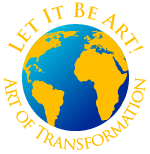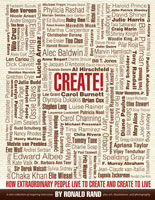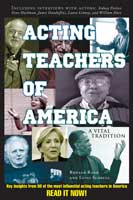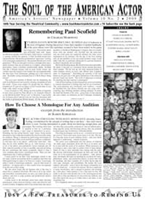|
For Teachers
Harold Clurman and The Group Theatre:
A Celebration and a Call to Action
| Part I & II | Part
III | Part IV | Part
V | Additional Materials | Student & Teacher
Feedback |
Educational Guide - Additonal Materials
REVIEW
OF CLURMAN PACKET QUESTIONS:
**Question 1: What driving forces shape theatre today?
**Question 2: Does the theatre today convey the life of our times?
**Question 3: What bearing do these factors (Politics/ economics, American
identity, Leadership) have on today’s theatre?
**Question 4: What Ideas drive our contemporary theatre?
**Question 5: What kind of funding is available to theatres today? Does
the present economic climate confront today’s theatres with challenges
similar to those faced by The Group Theatre?
ADDITIONAL QUESTIONS FOR CLASS DISCUSSION:
1. How can we become more proactive in shaping the art form to which
we devote our passion and energies?
2. What changes would benefit the theatre of tomorrow?
3. Does an American theatre or an American theatre tradition really
matter?
4. Do we have leaders and Ideas in the theatre today? Discuss. Why or
why not? Who might we consider our leaders?
5. How and to what extent are theatre students educated about Harold
Clurman and The Group Theatre? Summarize the knowledge you had before
this seminar and its source.
Why do theatre students not learn more about the history of the American theatre
(the theatre tradition we are all a part of)?
6. What aspects most interest you about the study of Clurman and The
Group Theatre?
What topics would you like to learn more about? What is the most interesting
way for you to study these topics or how could it be taught in the most enjoyable
way for students?
APPENDIX
SUGGESTED READING LISTS:
Books Written by Group Theatre Members:
By Harold Clurman:
The Fervent Years, 1945.** The Divine Pastime, 1974.
Lies Like Truth, 1958. All People are Famous, 1974.
On Directing, 1972. Ibsen, 1977.
The Naked Image, 1966. The Collected Works of Harold Clurman, 1994.**
By Stella Adler:
The Art of Acting, 2000.
The Technique of Acting, 1988.
Stella Adler on Ibsen, Strindberg, and Chekhov, 1999.
By Sanford Meisner:
Sanford Meisner on Acting, 1987.
By Lee Strasberg:
A Dream of Passion, 1987.
By Robert Lewis:
Advice to the Players, 1980.
Method or Madness?, 1958.
By Clifford Odets:
Waiting for Lefty and Other Plays, 1993.
The Time Is Ripe: The 1940 Journal of Clifford Odets, 1989.
By Cheryl Crawford:
One Naked Individual: My Fifty Years in the Theatre, 1977.
By Morris Carnovsky:
The Actor’s Eye, 1984.
**Indicates source quoted in Clurman packet.
Books Written About The Group Theatre and its Members:
(Listed alphabetically by author)
The Great Acting Teachers and Their Methods by Richard Brestoff, 1995.**
Reunion: A Self-Portrait of the Group Theatre by Helen Krich Chinoy,
1976.**
The Actors Studio: A Player’s Place by David Garfield, 1980.
Strasberg’s Method by S. Loraine Hull, 1985.
The Sanford Meisner Approach by Larry Silverberg, 1994.
Real Life Drama: The Group Theatre and America, 1931-1940 by Wendy Smith,
1992.**
Accidentally on Purpose: Reflections on Life, Acting, and the Nine Natural
Laws of Creativity by John Strasberg, 1996.
Other Suggested Reading for Theatre Artists: (Listed alphabetically by author)
A Director Prepares by Anne Bogart, 2001.
Acting: The First Six Lessons by Richard Boleslavsky, 1933.
The Empty Space by Peter Brook, 1968.
The Open Door by Peter Brook, 1987.
A Practical Handbook for the Actor by Melissa Bruder, Lee Michael Cohn,
Madeleine Olnek, Nathaniel Pollack, Robert Previto and Scott Zigler,
1986.
The Artist’s Way by Julia Cameron, 1992.
To The Actor on The Technique of Acting by Michael Chekhov, 1953.
Actors on Acting by Toby Cole and Helen Krich Chinoy, 1970.
Directors on Directing by Toby Cole, 1990.
Towards a Poor Theatre by Jerzy Grotowski, 1969.
A Challenge for the Actor by Uta Hagen, 1973.
How to be a Working Actor by Mari Lyn Henry and Lynne Rogers, 2000.
At Work With Grotowski on Physical Actions by Thomas Richards, 1995.
Letters to a Young Poet by Rainer Maria Rilke, 1945.
The Player’s Passion: Studies in the Science of Acting by Joseph
Roach, 1993.
An Actor Prepares by Constantin Stanislavsky, 1936.
Building a Character by Constantin Stanislavsky, 1949.
Creating a Role by Constantin Stanislavsky, 1961.
SUGGESTED FILMS:
The Trip to Bountiful (1985) with Geraldine Page
Frances (1982) with Jessica Lange and Kim Stanley
Raging Bull (1980) with Robert DeNiro, by Martin Scorsese
Taxi Driver (1976) with Robert DeNiro, Harvey Keitel, Jodie Foster,
directed by Martin Scorsese
The Godfather II (1974) with Al Pacino, Robert DeNiro, Robert Duvall,
Lee Strasberg
The Godfather I (1972) with Marlon Brando, Al Pacino, Robert Duvall
The Graduate (1967) with Dustin Hoffman, directed by Mike Nichols
The Last Angry Man (1959) with Paul Muni
Cat on a Hot Tin Roof (1958) with Paul Newman, Elizabeth Taylor, and
Burl Ives
The Three Faces of Eve (1957) with Joanne Woodward and Lee J. Cobb
East of Eden (1955) with James Dean and Julie Harris, directed by Elia
Kazan
On the Waterfront (1954) with Marlon Brando, directed by Elia Kazan
A Member of the Wedding (1952) with Julie Harris
A Streetcar Named Desire (1951) with Marlon Brando, directed by Elia
Kazan
A Tree Grows in Brooklyn (1945) directed by Elia Kazan
Golden Boy (1939) film version of Odets’ play, with Lee J. Cobb
et al.
The Life of Emile Zola (1937) with Paul Muni and Morris Carnovsky
| To Student & Teacher
Feedback |
| Part I & II | Part
III | Part IV | Part
V | Additional Materials | Student & Teacher
Feedback |
Download Educational Guide
You may open a copy of the above material by clicking on educational_guide.pdf,
to download a copy to your computer right click with your mouse. You
will need the program Adobe Acrobat Reader installed on you computer
to open this file. If you do not have Acrobat Reader you may obtain a
copy for FREE by clicking on the icon Get Acrobat Reader below.
Get Acrobat Reader
 Click
on the icon at left which will take you to Adobe where you can download
a free copy of Adobe Acrobat Reader. Click
on the icon at left which will take you to Adobe where you can download
a free copy of Adobe Acrobat Reader.
|











